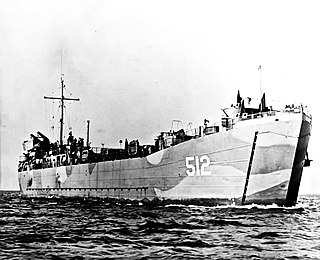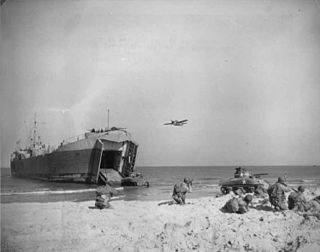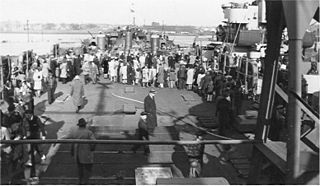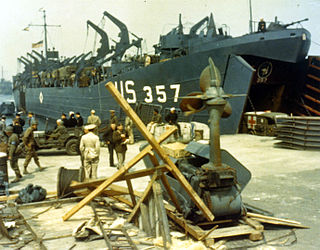
Landing Ship, Tank (LST), or tank landing ship, is the naval designation for ships first developed during World War II (1939–1945) to support amphibious operations by carrying tanks, vehicles, cargo, and landing troops directly onto shore with no docks or piers. This enabled amphibious assaults on almost any beach.

USS LST-380 was a LST-1-class tank landing ship of the United States Navy during World War II, later loaned to the Royal Navy.

USS LST-1 was an LST-1-class tank landing ship of the United States Navy built during World War II. She was the lead ship in her class of 390 and like many of her class, she was not named and is properly referred to by her hull designation.

USS LST-325 is a decommissioned tank landing ship of the United States Navy, now docked in Evansville, Indiana, US. Like many of her class, she was not named and is properly referred to by her hull designation.

USS Burnett County (LST-512) was an LST-491-class tank landing ship built for the United States Navy during World War II. Named for Burnett County, Wisconsin, she was the only U.S. Naval vessel to bear the name.

USS Berkeley County (LST-279) was an LST-1-class tank landing ship built for the United States Navy during World War II. Named for counties in South Carolina and West Virginia, she was the only U.S. Naval vessel to bear the name.

USS Berkshire County (LST-288) was an LST-1-class tank landing ship built for the United States Navy during World War II. Named for Berkshire County, Massachusetts, she was the only U.S. naval vessel to bear the name.

USS Bernalillo County (LST-306) was an LST-1-class tank landing ship built for the United States Navy during World War II. Named for Bernalillo County, New Mexico, she was the only U.S. Naval vessel to bear the name.

USS Blanco County (LST-344) was an LST-1-class tank landing ship built for the United States Navy during World War II. Named for Blanco County, Texas, she was the only U.S. Naval vessel to bear the name.

USS LST-356 was an LST-1-class tank landing ship built for the United States Navy during World War II. She earned three battle stars during the war and was decommissioned in July 1946. In July 1955, she was assigned the name USS Bledsoe County (LST-356) in honor of Bledsoe County, Tennessee, but never saw active service under that name. Bledsoe County was struck from the Naval Vessel Register in September 1960 and sold for scrapping in March 1961. She was apparently sold into commercial service in 1962 instead, serving under several names over the next five years. In 1967, she was acquired by the Indonesian Navy and renamed KRI Teluk Tomini (508). In 2012, the ship was decommissioned and scrapped.

USS LST-504 was an LST-491-class tank landing ship built for the United States Navy during World War II. Renamed USS Buchanan County (LST-504) for counties in Iowa, Missouri, and Virginia on 1 July 1955, she was the only U.S. Naval vessel to bear the name.

USS Buncombe County (LST-510) was an LST-491-class tank landing ship built for the United States Navy during World War II. Named for Buncombe County, North Carolina, she was the only U.S. Naval vessel to bear the name. She currently serves as a ferry between New London, Connecticut, and Orient, Long Island.

USS LST-317 was one of 390 tank landing ships (LSTs) built for the United States Navy during World War II.

USS LST-332 was one of 390 tank landing ships (LSTs) built for the United States Navy during World War II.

USS Cassia County (LST-527) was an LST-491-class tank landing ship built for the United States Navy during World War II. Named for Cassia County, Idaho, she was the only U.S. Naval vessel to bear the name. USS Cassia County is recognized for service in World War II during the Invasion of Normandy, and in the Korean War.

USS LST-16 was a LST-1-class tank landing ship built for the U.S. Navy during World War II. Like most ships in her class, she was not named and was known only by her designation. She was staffed by a U.S. Coast Guard crew throughout her service career.

USS LST-357 was an LST-1-class tank landing ship of the United States Navy active during the Second World War. Whilst never formally named, she was nicknamed Palermo Pete by her crew.
USS LST-6 was an LST-1-class tank landing ship of the United States Navy. LST-6 served in the European Theater of Operations, participating in the Allied invasion of Sicily, the Salerno Landings, and the Normandy landings. She was mined and sunk on 17 November 1944.

USS LST-355 was an LST-1-class tank landing ship of the United States Navy active during the Second World War.

USS LST-27 was a United States Navy LST-1-class tank landing ship used exclusively in the Europe-Africa-Middle East Theater during World War II and manned by a United States Coast Guard crew. Like many of her class, she was not named and is properly referred to by her hull designation.




















